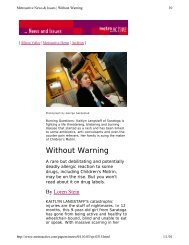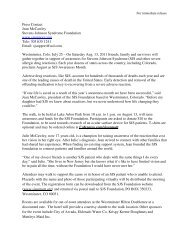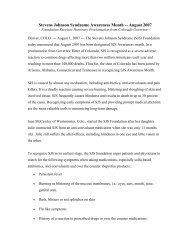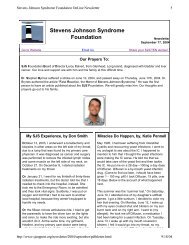1. Stevens-Johnson Syndrome and Toxic Epidermal Necrolysis
1. Stevens-Johnson Syndrome and Toxic Epidermal Necrolysis
1. Stevens-Johnson Syndrome and Toxic Epidermal Necrolysis
Create successful ePaper yourself
Turn your PDF publications into a flip-book with our unique Google optimized e-Paper software.
Treatment of Severe Drug Reactions<br />
<strong>1.</strong> <strong>Stevens</strong>-<strong>Johnson</strong> <strong>Syndrome</strong> <strong>and</strong> <strong>Toxic</strong> <strong>Epidermal</strong> <strong>Necrolysis</strong><br />
Definition<br />
SJS <strong>and</strong> TEN are variants of the same process, presenting as severe mucosal erosions<br />
with widespread erythematous, cutaneous macules or atypical targets. The cutaneous<br />
lesions often become confluent <strong>and</strong> show a positive Nikolsky sign <strong>and</strong> epidermal<br />
detachment. In SJS, epidermal detachment involves less than 10% of the total body skin<br />
area; transitional SJS-TEN is defined by an epidermal detachment between 10 <strong>and</strong> 30%;<br />
TEN is defined by a detachment greater than 30%. Full-thickness epidermal necrosis is<br />
observed on pathological examination. This clinical definition separates SJS-TEN from<br />
erythema multiforme major.<br />
Incidence<br />
Based on case registries <strong>and</strong> observational studies, the incidence of TEN is estimated to<br />
be 1-<strong>1.</strong>4 cases per million inhabitants per year. The incidence of SJS is probably of the<br />
same order (1-3 cases per million inhabitants per year). [1,2,3]<br />
Etiology/Risk Factors<br />
SJS-TEN is essentially drug-induced. Graft versus host disease is another wellestablished<br />
cause, independent of drugs. A few cases are related to infections<br />
(Mycoplasmapneumoniae), <strong>and</strong> a few other cases remain unexplained. The most<br />
extensive study of medication use <strong>and</strong> SJS-TEN mainly pointed to antibacterial<br />
sulfonamides, anticonvulsant agents, some nonsteroidal anti-inflammatory drugs <strong>and</strong><br />
allopurinol. [4] HIV infection dramatically increases the risk. A predisposing effect of<br />
autoimmune disorders, such as systemic lupus, <strong>and</strong> an HLA-linked, genetic susceptibility<br />
have been also suggested.<br />
Prognosis<br />
SJS-TEN is an acute, self-limited disease, with high morbidity, that is potentially lifethreatening.<br />
Mortality rates are 5% with SJS, 30-35% with TEN <strong>and</strong> 10-15% with<br />
transitional forms. <strong>Epidermal</strong> detachment may be extensive, to the entire skin surface. As<br />
in severe burns, fluid losses are massive, producing electrolyte imbalance. Superinfection,<br />
thermoregulation impairment, excessive energy expenditure, alteration of<br />
immunologic functions <strong>and</strong> hematologic abnormalities are usual systemic complications.<br />
Mucous membrane involvement (oropharynx, eyes, genitalia <strong>and</strong> anus) require attentive<br />
nursing care. The tracheobronchial epithelium, <strong>and</strong> less often gastrointestinal epithelium<br />
can be involved <strong>and</strong> cause high morbidity. Age, percentage of denuded skin, neutropenia,<br />
serum urea nitrogen level, <strong>and</strong> visceral involvement are prognostic factors. There are<br />
different scoring systems for vital prognosis estimation, SAPS <strong>and</strong> SAPS 11 (Simplified<br />
Acute Physiology Score), which are not specific. A specific score (SCORTEN) has been<br />
recently elaborated <strong>and</strong> validated. [5] After healing, altered pigmentation <strong>and</strong> corneal<br />
lesions are the main long-term complications.
Treatment<br />
Early management<br />
The management of patients must be prompt; early diagnosis with the early recognition<br />
<strong>and</strong> withdrawal of all potential causitive drugs is essential to a favorable outcome.<br />
Morbidity <strong>and</strong> mortality increase if the culprit drug is withdrawn late. We observed that<br />
death rates were lower when causative drugs with short elimination half-lives were<br />
withdrawn no later than the day when blisters or erosions first occurred. No difference<br />
was seen for drugs with long half-lives. [6]<br />
Second, intravenous fluid replacement must be initiated using macromolecules or saline<br />
solutions.<br />
Third, the patient must be transferred to an intensive care unit or a burn center. Prompt<br />
referral reduces risk of infection, mortality rate <strong>and</strong> length of hospitalization. [7,8,9]<br />
Symptomatic treatment<br />
General principles. The main types of symptomatic treatment are the same as for burns,<br />
<strong>and</strong> the experience of burn units is helpful for the treatment of TEN: environmental<br />
temperature control, careful <strong>and</strong> aseptic h<strong>and</strong>ling, sterile field creation, avoidance of any<br />
adhesive material, maintenance of venous peripheral access distant from affected areas<br />
(no central line when possible), initiation of oral nutrition by nasogastric tube,<br />
anticoagulation, prevention of stress ulcer, <strong>and</strong> medication administration for pain <strong>and</strong><br />
anxiety control are all essential.<br />
However, TEN <strong>and</strong> burned patients are not identical: burns happen in a very short time<br />
period (a few seconds) <strong>and</strong> do not spread thereafter; the TEN-SJS progress occurs during<br />
several days, including after hospital admittance. Cutaneous necrosis is more variable <strong>and</strong><br />
often deeper in burns than in TEN.<br />
These differences induce a some important management specificities. Subcutaneous<br />
edema is a very uncommon feature of TEN, in contrast with burns, probably because of<br />
milder injury to blood vessels. Therefore the fluid requirements of TEN patients are<br />
habitually two-thirds to three-fourths of those of patients with burns covering the same<br />
area. Since the lesions are restricted to the epidermis <strong>and</strong> usually spare the hair follicles,<br />
the regrowth of epidermis is quick in patients with SJS-TEN. This supports a different<br />
approach of topical treatment.<br />
Systemic management. Pulmonary care includes aerosols, bronchial aspiration <strong>and</strong><br />
physical therapy. If the trachea <strong>and</strong> bronchi are involved, intubation <strong>and</strong> mechanical<br />
ventilation are nearly always necessary. Early <strong>and</strong> continuous enteral nutrition decreases<br />
the risk of stress ulcer, reduces bacterial translocation <strong>and</strong> enterogenic infection, <strong>and</strong><br />
allows earlier discontinuation of venous lines. [10] Phosphorus levels must be measured<br />
<strong>and</strong> corrected, if necessary. Profound hypophosphoremia is frequent <strong>and</strong> may contribute<br />
to altered regulation of glycemia <strong>and</strong> to muscular dysfunction. Most authors do not use<br />
prophylactic antibiotics. Catheters are changed <strong>and</strong> cultured regularly. Bacterial sampling<br />
of the skin lesions is performed the first day <strong>and</strong> every 48 hours. Indications for antibiotic<br />
treatment include an increased number of bacteria cultured from the skin with selection
of a single strain, a sudden drop in temperature, <strong>and</strong> deterioration in the patient's<br />
condition. S. aureus is the main bacteria present during the first days, <strong>and</strong> gram negative<br />
strains appear later.<br />
Environmental temperature is raised to 30 to 32 degrees,C. This reduces caloric losses<br />
through the skin <strong>and</strong> the resultant shivering <strong>and</strong> stress. Heat loss can also be limited by<br />
raising the temperature of antiseptic baths to 35v' to 38(C <strong>and</strong> by using heat shields,<br />
infrared lamps, <strong>and</strong> air-fluidized beds.<br />
Some drugs are needed. Thromboembolism is an important cause of morbidity <strong>and</strong> death;<br />
effective anticoagulation with heparin is recommended for the duration of<br />
hospitalization. [11] Although this results in increased bleeding from the skin, it is usually<br />
limited in amount <strong>and</strong> does not require additional transfusion. Antacids reduce the<br />
incidence of gastric bleeding. Emotional <strong>and</strong> psychiatric support must not be forgotten.<br />
Tranquilizers such as diazepam <strong>and</strong> morphinic analgesics can be used liberally if the<br />
respiratory status permits.<br />
Insulin is administered when hyperglycemia leads to overt glycosuria or to increased<br />
osmolarity.<br />
Many reviews have been published about intravenous <strong>and</strong> oral supplementation on burn<br />
care: ox<strong>and</strong>rolone <strong>and</strong> human growth factor are effective for decreasing hypercatabolism<br />
<strong>and</strong> net nitrogenous loss; [12,13] ornithine alpha-ketoglutarate supplementation of enteral<br />
feeding is effective to reduce wound healing time; [14] high dose ascorbic acid (66 mg/kg<br />
per hour) given during the first 24 hours reduces fluid volume requirements. [15] The<br />
usefulness of these treatments is not established in TEN/SJS <strong>and</strong> is probably lower than<br />
for burns because of a shorter duration of skin detachment.<br />
Topical management. No consensus exists about topical care. Possible approaches may<br />
be conservative or more aggressive (large operative debridement). In our opinion,<br />
conservative care is better than any surgical method. Even though we did not perform any<br />
study, it has been our experience that the areas with a positive Nikolski, potentially<br />
detached by any trauma healed much more rapidly where the epidermis stayed on site<br />
than on similar areas where the epidermis had been detached. We leave in place the<br />
involved "detachable" epidermis <strong>and</strong> use dressings only to protect it. Topical antiseptics<br />
(0.5% silver nitrate or 0.05% chlorhexidine) are used to paint, bathe, or dress the patients.<br />
Dressings may be gauzes with petrolatum, silver nitrate, polyvidoneiodine, or hydrogels.<br />
Some authors use biologic skin covers after epidermal stripping (cadaveric allografts,<br />
cultured human allogeneic or autologous epidermal sheets). New dressings are being<br />
investigated: Apligraft(r), Biobrane(r), TransCyte(r) (human newborn fibroblasts cultured<br />
on the nylon mesh of Biobranee). In burns, topical recombinant bovine basic fibroblast<br />
growth factor allowed faster granulation tissue formation <strong>and</strong> epidermal regeneration than<br />
placebo. [16]<br />
Prevention of ocular sequelae requires daily examination by an ophtalmologist. Eye<br />
drops, physiologic saline, or antibiotics if needed, are instilled every 2 hours <strong>and</strong><br />
developing synechiae are disrupted by a blunt instrument. It is suggested that wearing
gas-permeable scleral contact lenses reduces photophobia <strong>and</strong> discomfort; these lenses<br />
improve visual acuity <strong>and</strong> heal corneal epithelial defects in half of patients. [17]<br />
Oral <strong>and</strong> nasal crusts are removed, <strong>and</strong> the mouth is sprayed with antiseptics several<br />
times a day.<br />
Specific treatment<br />
Corticosteroids. Corticosteroid use is highly debated. These drugs are a mainstay in<br />
some units, bur other investigators consider systemic corticosteroids to provoke<br />
prolonged wound healing, increased risk of infection, masking of early signs of sepsis,<br />
severe gastrointestinal bleeding <strong>and</strong> increased mortality. A review of the literature shows<br />
only patients series <strong>and</strong> no r<strong>and</strong>omized clinical trials. Several articles reported<br />
corticosteroids benefit: Tegelberg used 400 or 200 mg prednisone/day, gradually<br />
diminished over a 4 to 6 week period, <strong>and</strong> observed a single death among eight<br />
patients [18] . Others series claimed also excellent results but the diagnosis of SJS-TEN was<br />
debatable for most of the cases. [19,20,21,22,23] In two retrospective studies, no difference in<br />
mortality rates or infectious complications was noted in patients who received steroids<br />
before or after referral. [24,25]<br />
By contrast, other studies claimed that corticosteroid use was detrimental. Thirty patients<br />
with SJS or TEN were included in an uncontrolled prospective study. The first 15<br />
patients received corticosteroids <strong>and</strong> the mortality rate was 66%. Therefore, the next 15<br />
patients were treated without corticoids <strong>and</strong> the mortality rate was 33%. [26] Both groups<br />
were similar in other described aspects. However, 11 of the 15 patients "without<br />
corticosteroids" had received corticosteroids prior to referral. Thus no conclusion may be<br />
made about exclusive early administration of corticosteroids. In a retrospective study, a<br />
multivariate analysis of prognostic factors showed that corticosteroid therapy was an<br />
independent factor for increased mortality. [7] Other series provided the same<br />
conclusion. [27]<br />
Moreover, many TEN cases have occurred during treatment with high doses of<br />
corticosteroids for preexistent disease. [4,28,29]<br />
In conclusion, today, according to most authors, systemic corticosteroids are of unproven<br />
benefit in early forms <strong>and</strong> are clearly deleterious in advanced forms of TEN/SJS.<br />
Intravenous immunoglobulin (IVIG)<br />
One uncontrolled clinical trial pointed out the possible usefullness of IVIG. It was based<br />
on in vitro demonstration that intravenous immunoglobulins can inhibit Fas-Fas lig<strong>and</strong><br />
mediated apoptosis. Ten consecutive patients with TEN of moderate severity were treated<br />
with different doses of IVIG (0.2 to 0.75 g/kg of body weight per day for four<br />
consecutive days); all survived [30] . However, no r<strong>and</strong>omized clinical trial is published on<br />
this, <strong>and</strong> other authors have not obtained the same results. Rational evaluation of the<br />
benefit of this treatment cannot currently be done.<br />
Immunomodulating agents
Some case reports claimed a benefit of plasmapheresis for treatment of TEN/SJS.<br />
However, according to an open trial (8 consecutive patients with historical controls),<br />
plasma exchange produces no significant difference in mortality, length of hospital stay,<br />
or time to re-epithelialization. [31] Cyclophosphamide was also proposed. Eight patients<br />
with TEN were treated by only cyclophosphamide (initial dose: 300 mg per day); all<br />
survived. [32] Other series are not interpretable, on account of concomitant therapy by<br />
cyclophosphamide <strong>and</strong> corticosteroids. Anecdotally, some cases of cyclophosphamideinduced<br />
TEN were reported; one included a positive rechallenge test.<br />
In a retrospective comparative study, cyclosporin was safe <strong>and</strong> was associated with a<br />
more rapid re-epithelialization rate <strong>and</strong> a lower mortality rate (0/11 vs. 3/6) than<br />
treatment with cyclophosphamide <strong>and</strong> corticosteroids [33] . Cyclosporin has also received<br />
attention as a useful drug for treatment of TEN, however, further investigations are<br />
needed to evaluate the real value of cyclosporin.<br />
N-acetylcysteine. NAC increases the clearance of several drugs <strong>and</strong> their metabolites <strong>and</strong><br />
in vitro inhibits production of TNF-oc <strong>and</strong> IL- I P. We found no evidence of clinical<br />
effectiveness in TEN. A r<strong>and</strong>omized trial has shown lack of effectiveness of NAC in<br />
prevention of hypersensitivity reactions to trimethoprim-sulfamethoxazole in patients<br />
with HIV infection. [34] Moreover, high doses of NAC may inactivate not only the culprit<br />
drug but also other drugs, potentially useful for the patient.<br />
Other medications. We found only case reports but no good evidence on the use of<br />
granulocyte colony stimulating factor, heparin, monoclonal antibodies against cytokines<br />
<strong>and</strong> pentoxifylline.<br />
Thalidomide. Thalidomide has been proposed as a treatment of TEN because it is a<br />
potent inhibitor of TNF-a action. This drug was tested in the only r<strong>and</strong>omized clinical<br />
trial ever published in TEN. It was a double-blind, r<strong>and</strong>omized, placebo-controlled study;<br />
the regimen was a 5-day course of thalidomide 400 mg daily. The study was stopped after<br />
the inclusion of only 22 patients because there was an unexplained significant excess of<br />
mortality in the thalidomide group (10 of 12 patients died, compared with 3 of 10 in the<br />
placebo group). [35] Based on this unique trial, thalidomide seems to be detrimental in<br />
TEN.<br />
In conclusion, we believe that no specific treatment has been proven to be beneficial for<br />
TEN/SJS, which is a self-limited disease. For us, to date, the best management is<br />
supportive care alone.<br />
Follow-up<br />
Sequelae. Sun exposure must be avoided for several months because UV can worsen<br />
hyperpigmentation sequelae. Sunblocks are recommended.<br />
Ophthalmologic follow-up is m<strong>and</strong>atory looking for sicca syndrome, keratitis <strong>and</strong> corneal<br />
lesions. If needed, artificial tears <strong>and</strong> lubricants are prescribed. The most severe<br />
inflammatory corneal lesions may progress for months or years <strong>and</strong> result in severe<br />
impairment of vision. Corticosteroid eye drops are not effective in preventing the activity
of corneal lesions. Many ophthalmologists use topical cyclosporin, but there is no firm<br />
evidence for the efficacy of this treatment. The grafting of autologous cells from the<br />
limbus, supposed to contain stem cells is a promising approach. [36]<br />
Synechiae in the mouth or genitalia may necessitate surgery. Glycemia must be followedup<br />
because diabetes may develop after SJS-TEN.<br />
Prevention of recurrence. Survivors of TEN/SJS should not be re-exposed to the<br />
suspected offending agent(s) or to related compounds. For example, cross-reactions have<br />
been reported between different anticonvulsant agents or non-steroidal anti-inflammatory<br />
drugs, such as the oxicams. Drugs of the same pharmacologic class can be used provided<br />
they are structurally different from the culprit drug. Because genetic factors are suspected<br />
in drug-induced blistering disorders, the suspected drug should not be used in the blood<br />
relatives of the patient.<br />
There are no specific statistics on the risk of re-use of culprit drugs or on the possibility<br />
of desensitization in patients with TEN. Some data are available for prevention or for<br />
desensitization in benign cutaneous adverse drug reactions, especially in AIDS. [37,38,39]<br />
. Hypersensitivity <strong>Syndrome</strong> (DRESS)<br />
Definition<br />
A variety of hypersensitivity responses are responsible for most cutaneous reactions to<br />
drugs. The term 'hypersensitivity syndrome' usually refers to a specific, severe,<br />
idiosyncratic reaction, defined by a widespread <strong>and</strong> long-lasting papulopustular or<br />
erythematous skin eruption often progressing to exfoliative dermatitis, with fever,<br />
lymphadenopathy, <strong>and</strong> visceral involvement (hepatitis, pneumonitis, myocarditis,<br />
periarditis, nephritis). [40] Blood alterations are also rather characteristic with eosinophilia<br />
in about 90% <strong>and</strong> mononucleosis in about 40% of cases. [41] In order to clarify the<br />
nosology, we have proposed the acronym 'DRESS' (Drug Rash with Eosinophilia <strong>and</strong><br />
Systemic Symptoms) to name the hypersensitivity syndrome. [41]<br />
Incidence/Prevalence<br />
For phenytoin, carbamazepine, <strong>and</strong> phenobarbital, the incidence of DRESS has been<br />
estimated to 1 reaction per 5,000 to 10,000 exposures. [42]<br />
Etiology/Risk Factors<br />
By definition, drugs are the causal agent. Anticonvulsants, sulfonamides, dapsone,<br />
allopurinol, minocycline <strong>and</strong> gold salts are among the most frequent culprit drugs.<br />
Detoxification defects have been implicated in the pathophysiology of this syndrome,<br />
with an inherited component. Slow acetylation is probably one of the risk factors. A role<br />
of viral co-infection is also suspected (specifically, a reactivation of the herpes virus<br />
HHV6) [43,44,45] .
Prognosis<br />
DRESS is potentially life-threatening. The mortality rate is estimated at near 10%. In<br />
other cases, recovery is usually total. Rash <strong>and</strong> hepatitis may persist for weeks; some<br />
cases persist for months.<br />
Treatment<br />
Acute period<br />
DRESS syndrome must be promptly recognized <strong>and</strong> all potential culprit drugs<br />
whitdrawn. The typical delay between beginning the administration of a drug <strong>and</strong> the<br />
onset of the reaction is two to six weeks.<br />
Systemic corticosteroids are often used (0.5 to I mg/kg). This therapy rapidly improves<br />
symptoms <strong>and</strong> laboratory measurements, but its impact on the long term disease course is<br />
not known. Controlled clinical trials are lacking. Relapses of rash <strong>and</strong> hepatitis may occur<br />
as corticosteroids are tapered. A chronic HHV6 activation promoted by systemic steroids<br />
could explain these relapses.<br />
While waiting for better evidence, we recommend using systemic steroids only for<br />
patients with life-threatening visceral manifestations such as insterstitial pneumonitis or<br />
nephrirtis. In milder cases, topical steroids improve the skin manifestations. Interferon cc<br />
has been used in a few cases of long-lasting DRESS. This is not enough to allow<br />
appropriate evaluation.<br />
When the skin rash results in exfoliative dermatitis supportive care consists of warming<br />
the environmental temperature <strong>and</strong> using local antiseptics <strong>and</strong> topical corticosteroids. If<br />
the erythroderma is severe, the cutaneous blood flow is significantly increased; cardiac<br />
failure may occur in elderly patients or those with prior cardiac disease <strong>and</strong> should be<br />
carefully monitored <strong>and</strong> treated. Oral antipyretics <strong>and</strong> topical corticosteroids are helpful<br />
to decrease this risk.<br />
Prevention of recurrence<br />
To distinguish the culprit drug among several suspected drugs, drug administration<br />
timing <strong>and</strong> its temporal relationship to the onset of the syndrome must be evaluated in<br />
detail. The use of flow sheets documenting symptoms, drugs <strong>and</strong> dates may be helpful.<br />
Consideration must be given to the liklihood of a particular drug to cause the syndrome<br />
when multiple drugs are involved. Patch tests <strong>and</strong> in-vitro lymphocyte tests have been<br />
used, but the sensitivity <strong>and</strong> specificity of these tests are variable, depending on the drug.<br />
Cross-reactions are frequent between the three main aromatic anticonvulsants (phenytoin,<br />
carbamazepine, phenobarbital), <strong>and</strong> all three must be avoided by the patient if one has<br />
been causative. It may be difficult to find a safe alternative anticonvulsant therapy.<br />
As for TEN/SJS, first-degree relatives should be alerted to their elevated risk of such<br />
reactions to the same drug(s).
Authors:<br />
Pierre-Dominique Ghislain M.D., Jean-Claude Roujeau, M.D., Department of Dermatology,<br />
H6pital Henri Mondor, Universit6 Paris XII, Cr6teil, France<br />
Dermatol Online J 8(1), 2002. © 2002 Arthur C. Huntley, MD








